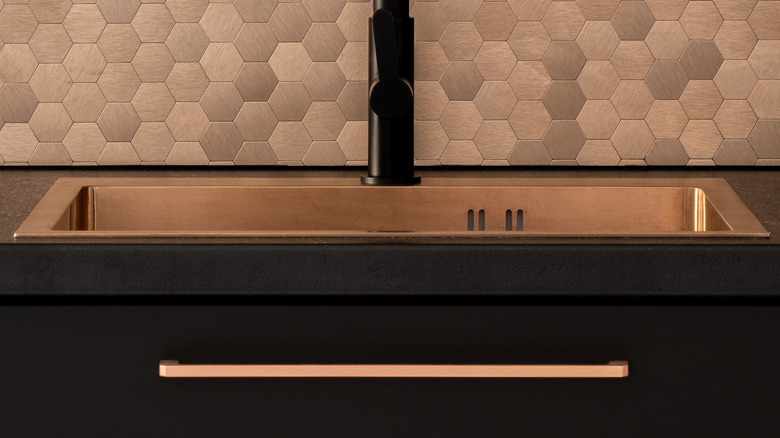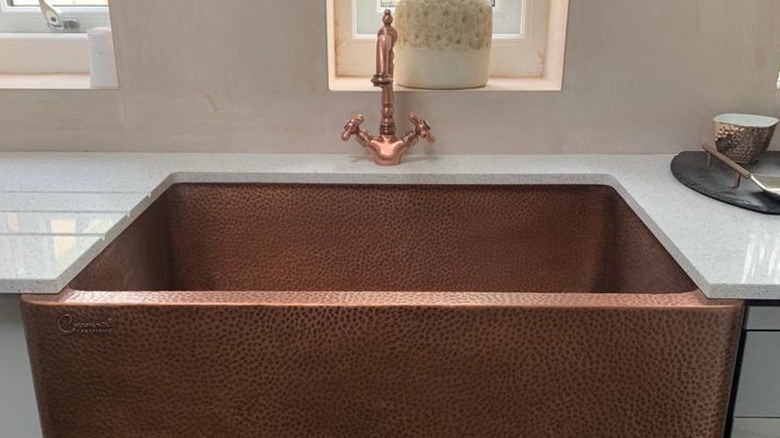The Pros And Cons Of Installing A Copper Sink In Your Kitchen
You might not be aware of just how many options you have when it comes to kitchen sink materials. Stainless steel is a common choice among homeowners, but it arguably does not add much character to a kitchen. Copper is one of the most often overlooked options. With its rich, warm color and rustic look, the material is certainly visually appealing. However, it is important to weigh the pros and cons before deciding whether copper is the right choice for your kitchen sink. The material is long-lasting, antibacterial, and aesthetically pleasing. Unfortunately, it is also prone to damaging chemical reactions, expensive, and requires professional installation.
Copper is one of the many stunning nontraditional sink materials that make a statement, so you might find that it is worth considering. With all of the pros and cons, it is up to you to decide whether the material works for your home. Copper is not the most low-maintenance option, so it may not be the best fit for those with a busy lifestyle. Depending on your budget, you may also want to go for something more affordable. Still, the material's many benefits will outweigh the cons for many homeowners.
Copper sinks are a long-lasting statement piece
Those who have kitchens with beautiful copper sinks are likely all too familiar with the many benefits. One of the most unique perks of copper sinks is the fact that they are naturally antibacterial. In fact, the U.S. Environmental Protection Agency (EPA) even confirmed that certain copper alloys can kill the COVID-19 causing virus SARS-CoV-2.
Another pro associated with copper sinks is that they last far longer than sinks made from other materials. They do not have to be replaced as often as many of the more popular alternatives. You might find that this justifies the high price point. Copper sinks can last over 30 years. Meanwhile, stainless steel sinks only last for 15 to 30 years. This is assuming that you maintain your copper sink properly. There are a few copper sink cleaning tricks that will help prevent damage. Only use copper cleaner rather than other cleaning solutions, and wipe your sink down with a dry cloth after use rather than leaving it wet. Finally, copper sinks are incredibly stylish. They are a perfect fit for those seeking a rustic look in their kitchen. When it comes to kitchen design, many people overlook just how much of an impact their sink material can have on the space. Investing in a copper sink might allow you to skip over other pricey design additions because it is such a statement piece.
Copper sinks are costly and difficult to install
Despite all of the perks associated with copper sinks, they are not a widely used design element. This is likely due in part to their many downsides. Unfortunately, copper sinks are very pricey compared to other options. It can cost up to $2,000 to install a sink crafted from this material. For reference, the average sink installation is only $400. Although copper is generally expensive, there are still some decently priced options out there. For example, Wayfair sells a Single Bowl Copper Kitchen Sink for only $130.
Along with the high price point, another con of copper sinks is that you cannot install them yourself. This means that you unfortunately will not be able to rely on DIY installation as a way to cut the costs down a bit. Copper sink additions are better left to the professionals because the material is extremely heavy and requires special plumbing knowledge. Finally, copper sinks undergo the patina process over time. Patina is a dark tone that develops over once bright and shiny copper as it ages. This can either be a positive or a negative depending on your preferences. It is a natural component of the copper aging process, so be prepared for your sink to look different in the coming years if you opt for copper. Certain substances can strip patina away, giving copper sinks a blotchy look. This includes acidic chemicals, certain cosmetics, bleach, and more.



